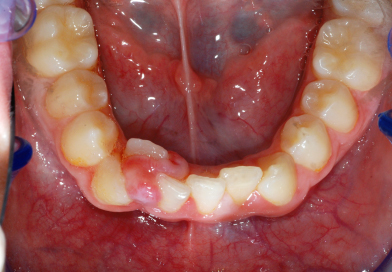38
Swellings and Enlargements of the Gingiva
Epulides (Box 38.1)
An epulis is a swelling on the gingiva and is a non-specific term. Most epulides are inflammatory or reactive lesions to plaque or other gingival irritants. They are usually well circumscribed and pedunculated and, while the precise cause may not be determined, they are easily managed by surgical excision with a small border of normal tissue. It is important to remember that some of these lesions have a large vascular component and may bleed excessively on removal.
Pyogenic Granuloma/Fibrous Epulis (Fig. 38.1)
Perhaps the most common epulis, the misnamed pyogenic granuloma (no pus is present) is a slow-growing, well circumscribed, usually pedunculated lesion that is a more highly vascular variant of the fibrous epulis. They are extremely variable in appearance and usually arise from the inderdental papilla. Some authors describe this as a form of capillary haemangioma.
Figure 38.1 A gingival epulis. Most of these lesions are reactive and represent an overgrowth of tissue in response to mild irritation. Surgical removal is straightforward but must include a border of normal tissue. Most do not recur.

Peripheral Giant Cell Granuloma
This lesion occurs only in the region of the primary dentition and is usually dark in colour. Importantly they have a tendency to regrow if not completely excised. There is a characteristic radiographic cupping of the bone and histologically they have numerous multinucleated giant cells.
Papilloma/Viral Warts/Condyloma Acuminatum
Most papillomas and viral warts in children are associated with the human papilloma virus and are verrucous exophytic growths. They are commonly associated with extra-oral lesions on the han/>
Stay updated, free dental videos. Join our Telegram channel

VIDEdental - Online dental courses


